The Oilfield Stimulation Chemicals Market is estimated to be valued at USD 6.0 billion in 2025 and is projected to reach USD 11.3 billion by 2035, registering a compound annual growth rate (CAGR) of 6.5% over the forecast period.
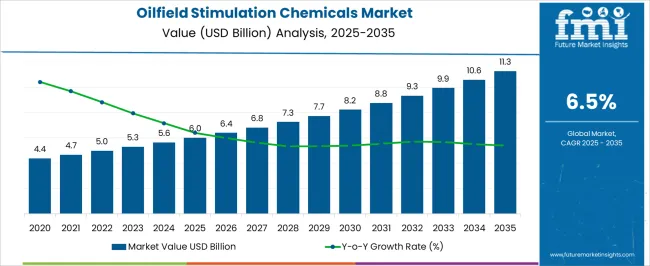
| Metric | Value |
|---|---|
| Oilfield Stimulation Chemicals Market Estimated Value in (2025 E) | USD 6.0 billion |
| Oilfield Stimulation Chemicals Market Forecast Value in (2035 F) | USD 11.3 billion |
| Forecast CAGR (2025 to 2035) | 6.5% |
The Oilfield Stimulation Chemicals market is witnessing steady growth, driven by the increasing demand for enhanced oil recovery and optimized production from aging and unconventional reservoirs. Rising global energy requirements, coupled with the need to maximize extraction efficiency, are supporting the adoption of advanced stimulation chemicals. Technological advancements in chemical formulations, including acids, surfactants, and viscosifiers, are improving reservoir stimulation performance and reducing operational risks.
Regulatory focus on safe and environmentally responsible chemical usage has encouraged the development of more efficient and less hazardous solutions, enhancing market acceptance. Increasing investments in hydraulic fracturing and well stimulation projects across North America, the Middle East, and Asia Pacific are contributing to market expansion.
The integration of data-driven reservoir analysis and monitoring systems is further optimizing chemical utilization and operational efficiency As exploration and production activities intensify in challenging reservoirs, the demand for high-performance stimulation chemicals is expected to sustain long-term growth, driven by technological innovation, operational cost efficiency, and regulatory compliance.
The oilfield stimulation chemicals market is segmented by type, applications, and geographic regions. By type, oilfield stimulation chemicals market is divided into Acids, Biocides, Corrosion Inhibitors, Friction Reducers, Gelling Agents/ Viscosifiers, Iron Control Agents, Water Control Polymers, Breakers, and Others. In terms of applications, oilfield stimulation chemicals market is classified into Hydraulic Fracturing, Matrix Treatments, Acid Fracking, and Others. Regionally, the oilfield stimulation chemicals industry is classified into North America, Latin America, Western Europe, Eastern Europe, Balkan & Baltic Countries, Russia & Belarus, Central Asia, East Asia, South Asia & Pacific, and the Middle East & Africa.
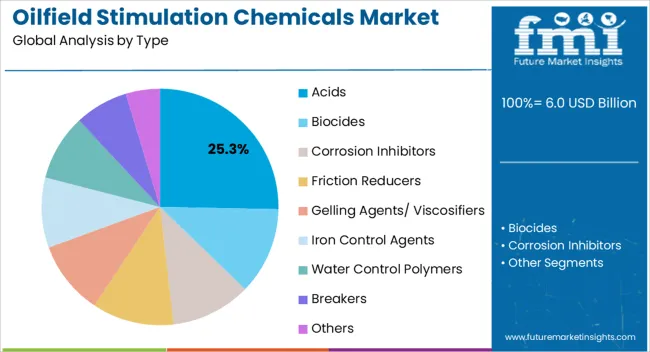
The acids segment is projected to hold 25.3% of the market revenue in 2025, establishing it as the leading type within oilfield stimulation chemicals. Its dominance is driven by the effectiveness of acids in dissolving formation deposits, enhancing permeability, and improving hydrocarbon flow in both conventional and unconventional reservoirs. These chemicals enable operators to achieve higher extraction efficiency and reduce the risk of formation damage.
Advanced formulations, including hydrochloric and organic acids, are being engineered to provide controlled reaction rates, minimize corrosion, and enhance safety. Integration with modern well stimulation technologies, such as coiled tubing and downhole delivery systems, further supports adoption.
Operational cost benefits, improved production rates, and compatibility with other stimulation chemicals strengthen the market position of acids As exploration moves into more complex reservoirs and deeper wells, acids are expected to remain the preferred choice for stimulation, driven by their proven effectiveness, adaptability, and contribution to enhanced oil recovery.
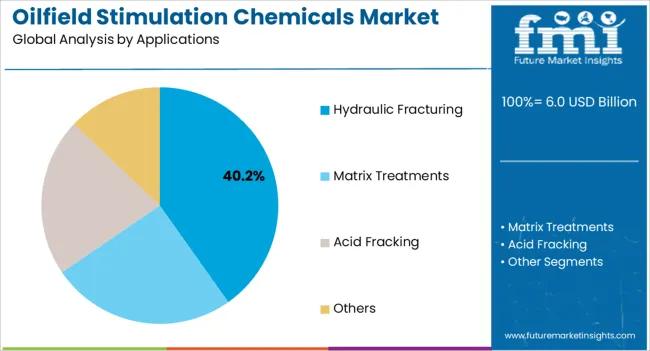
The hydraulic fracturing applications segment is anticipated to account for 40.2% of the market revenue in 2025, making it the leading application area. Its growth is being driven by the increasing use of hydraulic fracturing to unlock hydrocarbons from shale and other unconventional reservoirs. Stimulation chemicals, including acids and surfactants, are critical in enhancing fracture propagation, reducing formation damage, and optimizing hydrocarbon flow.
Advanced chemical formulations improve proppant transport, control fluid viscosity, and mitigate scaling or corrosion risks, thereby increasing operational efficiency. Rising investments in shale gas and tight oil projects across North America and Asia Pacific are further propelling the demand for chemical solutions tailored for hydraulic fracturing.
Environmental regulations and operational safety standards have encouraged the development of more sustainable and effective chemicals As energy demand continues to rise and unconventional resource exploitation expands, hydraulic fracturing is expected to remain the primary driver of growth in the oilfield stimulation chemicals market, supported by technological innovation, enhanced chemical performance, and cost efficiency.
Oilfield Stimulation Chemicals are revolutionary products that are designed to support and enhance the stimulation process during oil extraction. Stimulation treatments are carried out to improve or restore the productivity of an oil well. Oilfield Stimulation Chemicals helps in the free flow of hydrocarbons from wells.
Oilfield Stimulation Chemicals are commonly used in hydraulic fracturing treatment and matrix treatments especially in the processes of emulsification, wetting, and compatibilization. Oilfield Stimulation Chemicals are also used in high-stability foaming systems for formation blocking and foam fracturing. It is also used in down-hole stimulation fluids including slick water fracturing applications.
Oilfield Stimulation Chemicals are finding high usage in various applications and new geographical areas which are driving the market. Different types of chemicals are used in the various process of oil extraction viz. acids, biocides, corrosion inhibitors, friction reducers, gelling agents/ viscosities, iron control agents, water control polymers and breakers.
Out of these, gelling agents or viscosities is the most widely used oilfield stimulation chemical with largest market share. Most commonly used technique among oilfield stimulation is acid stimulation whose work is to clean existing fractures by dissolving filling materials (mostly drilling mud or secondary minerals) and molding them for an efficient removal.
Acid treatment technique is used in bearing rock formations for many years to maintain or increase the rate of flow of oil from production wells or the rate of flow of oil-displacing fluids into injection wells. Because of its vast usage oilfield, stimulation chemicals market will witness an escalating demand in the oil industry.
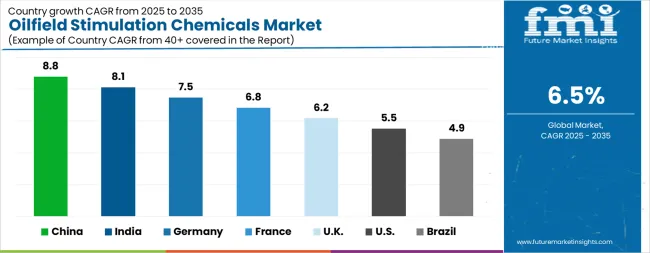
| Country | CAGR |
|---|---|
| China | 8.8% |
| India | 8.1% |
| Germany | 7.5% |
| France | 6.8% |
| UK | 6.2% |
| USA | 5.5% |
| Brazil | 4.9% |
The Oilfield Stimulation Chemicals Market is expected to register a CAGR of 6.5% during the forecast period, exhibiting varied country level momentum. China leads with the highest CAGR of 8.8%, followed by India at 8.1%. Developed markets such as Germany, France, and the UK continue to expand steadily, while the USA is likely to grow at consistent rates. Brazil posts the lowest CAGR at 4.9%, yet still underscores a broadly positive trajectory for the global Oilfield Stimulation Chemicals Market. In 2024, Germany held a dominant revenue in the Western Europe market and is expected to grow with a CAGR of 7.5%. The USA Oilfield Stimulation Chemicals Market is estimated to be valued at USD 2.3 billion in 2025 and is anticipated to reach a valuation of USD 3.9 billion by 2035. Sales are projected to rise at a CAGR of 5.5% over the forecast period between 2025 and 2035. While Japan and South Korea markets are estimated to be valued at USD 309.6 million and USD 182.3 million respectively in 2025.
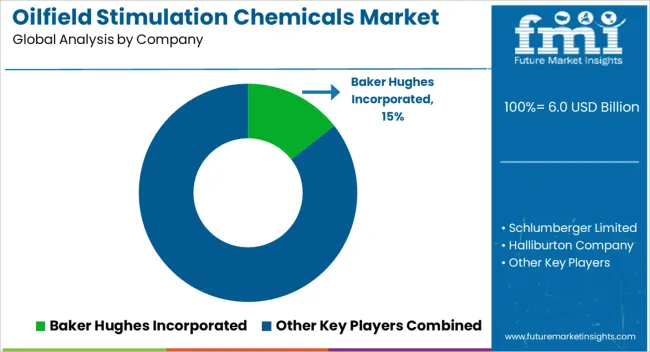
| Item | Value |
|---|---|
| Quantitative Units | USD 6.0 Billion |
| Type | Acids, Biocides, Corrosion Inhibitors, Friction Reducers, Gelling Agents/ Viscosifiers, Iron Control Agents, Water Control Polymers, Breakers, and Others |
| Applications | Hydraulic Fracturing, Matrix Treatments, Acid Fracking, and Others |
| Regions Covered | North America, Europe, Asia-Pacific, Latin America, Middle East & Africa |
| Country Covered | United States, Canada, Germany, France, United Kingdom, China, Japan, India, Brazil, South Africa |
| Key Companies Profiled | Baker Hughes Incorporated, Schlumberger Limited, Halliburton Company, BASF SE, Dow Chemical Company, Clariant AG, Akzo Nobel N.V., Albemarle Corporation, Chevron Phillips Chemical Company, Ecolab Inc., Huntsman Corporation, Solvay S.A., Ashland Global Holdings Inc., Kemira Oyj, Stepan Company, and Croda International Plc |
The global oilfield stimulation chemicals market is estimated to be valued at USD 6.0 billion in 2025.
The market size for the oilfield stimulation chemicals market is projected to reach USD 11.3 billion by 2035.
The oilfield stimulation chemicals market is expected to grow at a 6.5% CAGR between 2025 and 2035.
The key product types in oilfield stimulation chemicals market are acids, biocides, corrosion inhibitors, friction reducers, gelling agents/ viscosifiers, iron control agents, water control polymers, breakers and others.
In terms of applications, hydraulic fracturing segment to command 40.2% share in the oilfield stimulation chemicals market in 2025.






Our Research Products

The "Full Research Suite" delivers actionable market intel, deep dives on markets or technologies, so clients act faster, cut risk, and unlock growth.

The Leaderboard benchmarks and ranks top vendors, classifying them as Established Leaders, Leading Challengers, or Disruptors & Challengers.

Locates where complements amplify value and substitutes erode it, forecasting net impact by horizon

We deliver granular, decision-grade intel: market sizing, 5-year forecasts, pricing, adoption, usage, revenue, and operational KPIs—plus competitor tracking, regulation, and value chains—across 60 countries broadly.

Spot the shifts before they hit your P&L. We track inflection points, adoption curves, pricing moves, and ecosystem plays to show where demand is heading, why it is changing, and what to do next across high-growth markets and disruptive tech

Real-time reads of user behavior. We track shifting priorities, perceptions of today’s and next-gen services, and provider experience, then pace how fast tech moves from trial to adoption, blending buyer, consumer, and channel inputs with social signals (#WhySwitch, #UX).

Partner with our analyst team to build a custom report designed around your business priorities. From analysing market trends to assessing competitors or crafting bespoke datasets, we tailor insights to your needs.
Supplier Intelligence
Discovery & Profiling
Capacity & Footprint
Performance & Risk
Compliance & Governance
Commercial Readiness
Who Supplies Whom
Scorecards & Shortlists
Playbooks & Docs
Category Intelligence
Definition & Scope
Demand & Use Cases
Cost Drivers
Market Structure
Supply Chain Map
Trade & Policy
Operating Norms
Deliverables
Buyer Intelligence
Account Basics
Spend & Scope
Procurement Model
Vendor Requirements
Terms & Policies
Entry Strategy
Pain Points & Triggers
Outputs
Pricing Analysis
Benchmarks
Trends
Should-Cost
Indexation
Landed Cost
Commercial Terms
Deliverables
Brand Analysis
Positioning & Value Prop
Share & Presence
Customer Evidence
Go-to-Market
Digital & Reputation
Compliance & Trust
KPIs & Gaps
Outputs
Full Research Suite comprises of:
Market outlook & trends analysis
Interviews & case studies
Strategic recommendations
Vendor profiles & capabilities analysis
5-year forecasts
8 regions and 60+ country-level data splits
Market segment data splits
12 months of continuous data updates
DELIVERED AS:
PDF EXCEL ONLINE
Oilfield Scale Inhibitor Market Size and Share Forecast Outlook 2025 to 2035
Oilfield Communications Market Size and Share Forecast Outlook 2025 to 2035
Oilfield Surfactants Market Size and Share Forecast Outlook 2025 to 2035
Oilfield Roller Chain Market
Oilfield Chemicals Market Report - Growth, Demand & Forecast 2025 to 2035
Oilfield Production Chemicals Market – Trends & Forecast 2025 to 2035
Rig and Oilfield Mat Market Size and Share Forecast Outlook 2025 to 2035
Digital Oilfield Solutions Market Growth - Trends & Forecast 2025 to 2035
Digital Oilfield Market Growth – Trends & Forecast 2024-2034
Operational Digital Oilfield Solution Market Size and Share Forecast Outlook 2025 to 2035
Well Stimulation Materials Market Size and Share Forecast Outlook 2025 to 2035
Neurostimulation Market Growth - Size, Trends & Forecast 2025 to 2035
Photostimulation Lasers Market
Wound Stimulation Therapy Market Insights – Demand and Growth Forecast 2025 to 2035
The Muscle Stimulation Devices Market is segmented by Product, Application and End User from 2025 to 2035
Motion Stimulation Therapy Market Trends – Growth & Forecast 2024-2034
MRI-Safe Neurostimulation Systems Market Growth - Trends & Forecast 2025 to 2035
Non-invasive Brain Stimulation System Market Size and Share Forecast Outlook 2025 to 2035
Functional Electrical Stimulation (FES) Market Trends - Growth & Forecast 2025 to 2035
Repetitive Transcranial Magnetic Stimulation Market Size and Share Forecast Outlook 2025 to 2035

Thank you!
You will receive an email from our Business Development Manager. Please be sure to check your SPAM/JUNK folder too.
Chat With
MaRIA